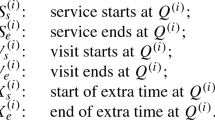Abstract
We consider a system ofN queues served by a single server in cyclic order. Each queue has its own distinct Poisson arrival stream and its own distinct general service-time distribution (asymmetric queues), and each queue has its own distinct distribution of switchover time (the time required for the server to travel from that queue to the next). We consider two versions of this classical polling model: In the first, which we refer to as the zero-switchover-times model, it is assumed that all switchover times are zero and the server stops traveling whenever the system becomes empty. In the second, which we refer to as the nonzero-switchover-times model, it is assumed that the sum of all switchover times in a cycle is nonzero and the server does not stop traveling when the system is empty. After providing a new analysis for the zero-switchover-times model, we obtain, for a host of service disciplines, transform results that completely characterize the relationship between the waiting times in these two, operationally-different, polling models. These results can be used to derive simple relations that express (all) waiting-time moments in the nonzero-switchover-times model in terms of those in the zero-switchover-times model. Our results, therefore, generalize corresponding results for the expected waiting times obtained recently by Fuhrmann [Queueing Systems 11 (1992) 109—120] and Cooper, Niu, and Srinivasan [to appear in Oper. Res.].
Similar content being viewed by others
Explore related subjects
Discover the latest articles and news from researchers in related subjects, suggested using machine learning.References
R.B. Cooper, Queues served in cyclic order: Waiting times, Bell Syst. Tech. J. 49 (1970) 399–413.
R.B. Cooper,Introduction to Queueing Theory, 2nd Ed. (North-Holland, Amsterdam, 1981, reprinted by CEEPress of The George Washington University, 1990).
R.B. Cooper and G. Murray, Queues served in cyclic order, Bell Syst. Tech. J. 48 (1969) 675–689.
R.B. Cooper, S.-C. Niu and M.M. Srinivasan, A decomposition theorem for polling models: The switchover times are effectively additive, Technical Report (1992), to appear in Oper. Res.
M. Eisenberg, Queues with periodic service and changeover time, Oper. Res. 20 (1972) 440–451.
M. Eisenberg, The polling system with a stopping server, Queueing Systems 18 (1994) 387–431.
S.W. Fuhrmann, Performance analysis of a class of cyclic schedules, Technical Report, AT&T Bell Laboratories (1981).
S.W. Fuhrmann, A decomposition result for a class of polling models, Queueing systems 11 (1992) 109–120.
S.W. Fuhrmann and R.B. Cooper, Stochastic decompositions in theM/G/1 queue with generalized vacations, Oper. Res. 33 (1985) 1117–1129.
G.M. Garner, Mean and variance of waiting time for nonsymmetric cyclic queueing systems, Technical Report, AT&T Bell Laboratories (1990).
D.P. Heyman and S. Stidham, Jr., The relation between customer and time averages in queues, Oper. Res. 28 (1980) 983–994.
A.G. Konheim, H. Levy and M.M. Srinivasan, Descendant set: An efficient approach for the analysis of polling systems, IEEE Trans. Commun. 42 (1993) 1245–1253.
P.J. Kuehn, Multiqueue systems with nonexhaustive cyclic service, Bell Syst. Tech. J. 58 (1979) 671–698.
H. Levy and L. Kleinrock, Polling systems with zero switch-over periods: A general method for analyzing expected delay, Perform. Eval. 13 (1991) 97–107.
L. Takács, A single-server queue with Poisson input, Oper. Res. 10 (1962) 388–397.
H. Takagi, Queueing analysis of polling models: An update, in:Stochastic Analysis of Computer and Communication Systems, ed. H. Takagi (North Holland, Amsterdam, 1990) pp. 267–318.
H. Takagi, Queueing analysis of polling models: Progress in 1990–93, Institute of Socio-Economic Planning, University of Tsukuba, Japan (1994).
S. Tayur and D. Sarkar, Implementing an effective algorithm to calculate waiting times in nonsymmetric cyclic queueing system, Technical Report, AT&T Bell Laboratories (1989).
R.W. Wolff, Poisson arrivals see time averages, Oper. Res. 30 (1982) 223–231.
R.W. Wolff,Stochastic Modeling and the Theory of Queues (Prentice-Hall, Englewood Cliffs, NJ, 1989).
Author information
Authors and Affiliations
Additional information
Research supported in part by the National Science Foundation under grant DDM-9001751.
Rights and permissions
About this article
Cite this article
Srinivasan, M.M., Niu, SC. & Cooper, R.B. Relating polling models with zero and nonzero switchover times. Queueing Syst 19, 149–168 (1995). https://doi.org/10.1007/BF01148944
Received:
Revised:
Issue Date:
DOI: https://doi.org/10.1007/BF01148944




